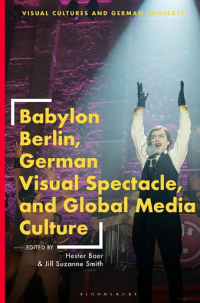Foreign language studies are overlooked. A mandate would change that.
After spending a summer immersed in Jaipur, India, one University of Maryland student argues that language learning isn’t just a personal skill—it’s a global necessity.


Research in the School of Languages, Literatures and Cultures is interdisciplinary and vibrant.
Faculty and graduate students pursue research in numerous fields of study.
Caleidoscopio es una ventana a los esplendores secretos del mundo de Carmen Benito-Vessels en 49 narraciones ––algunas cuentos, otras ejercicios de memoria, algunas más observaciones sobre lo que no se entiende del mundo, pero debería entenderse—. Esta colección es un fichero de historias, a menudo hilarantes y siempre agudas, en las que una mente curiosa y elegante medita sobre lo chico en lo grande, sobre lo que solo se puede encontrar entrelíneas, sobre lo que da claridad entre la opacidad de lo grandilocuente. Si leer ficción es siempre una necesidad crítica ––leyendo aprendemos maneras nuevas de pensar–– y una empresa estética ––ciertas escrituras nos dan placer––, en Caleidoscopio de Carmen Benito-Vessels el placer critico viene de la posibilidad de ver al mundo desde un lugar que hace brillar lo que muestra.
Grupo Editorial Círculo Rojo SL (December 30, 2024)
One challenge of learning a second or additional language (L2C) is learning to perceive and interpret its sounds. This includes acquiring the target language (TL) contrastive phonemic inventory, the sounds’ systematic behavior
in the TL phonology, and novel relationships between spelling and sound (GPCs; grapheme-phoneme correspondences). Many perception tasks require stipulation of written labels for target speech sounds (e.g., phoneme detection). Listening for this target is not necessarily, or even frequently, an equivalent cognitive task between participant groups. The incongruence of phonological and orthographic domains and their GPCs poses a methodological challenge for L2C research. The author argues that phoneme detection tasks should avoid the phone of investigative interest (x) as the direct target of listener attention and redirect focus to an adjacent listening target (y). Ideally, this target should not trigger or otherwise be implicated in the phonological process or phonotactic
constraint under investigation. The careful choice of listening target (y) with both a familiar sound and a congruent orthographic label for both (or all) language groups of the experiment yields an equivalent task and better indicates implicit knowledge of the phenomenon under study. This approach opens up potential choices of phonological objects of interest (x). The two phoneme detection experiments reported here employ this novel adjacent-congruent listening target approach, which the author calls the Persean approach. Experiment 1 establishes baseline performance in two assimilation types and replicates processing inhibition in first-language (L1) German speakers in response to violations of regressive nasal assimilation. It also uses [t] as the Persean listening target to test sensitivity to preceding violations of progressive dorsal fricative assimilation (DFA). Experiment 2 investigates sensitivity to violations of DFA in both L1 German speakers and L1 English L2C German learners. Experiment 2 also uses the Persean method for the first phoneme detection investigation demonstrating sensitivity to violation of a prosodic/phonotactic constraint banning /h/ in syllable codas. The study demonstrates that phoneme detection with Persean listening targets is a viable instrument for investigating regressive and progressive assimilation, prosodic/phonotactic constraints, and prelexical perceptual repair strategies in different language background groups and proposes statistical best practices for future phoneme detection research.

This interactive guide intends to accompany Carmen Benito-Vessels’ research about early modern Spain and the early modern United States (2018, 2022, and 2023). The primary goal of this project is to bring to light 16th-century colonial events that happened in the Eastern United States and shaped the history of both countries.
Read More about The Missing Link. Early Modern Spain and Early Modern US
Non-readers, who lack alphabetic literacy, may perform differently from alphabetically literate readers on tasks that draw upon phonological awareness, or may fail to perform them at all, despite their lexical and grammatical capabilities. But for alphabetically literate, reading adult learners of a second or subsequent language (L2+) in instructed foreign language (FL) settings, phonological representations typically entail both speech sound categories and orthographic labels, domains connected by grapheme-phoneme correspondences (GPCs) on a language-specific basis. A long tradition of auditory phonetic training research demonstrates benefits for aural perception of novel L2+ contrasts, but such training studies focus almost exclusively on gains in L2+ aural perception and articulatory production rather than connection to the orthographic domain. Our study investigates how phonetic training impacts the phonological and orthographic domains, including category perception and target-language (TL) GPCs, across the crucial differences between first language (L1) categories vs. L2+ categories and between naïve pre-learners in cross-language speech perception vs. L2+ learners in L2+ speech perception at early stages of exposure. The paper reports preliminary results on one novel vowel condition (represented by German Ü) and one novel consonant condition (represented by German CH). The L2+ Sound Learning Lab, led by Dr. John H.G. Scott (principal investigator) presented these findings at the 2023 Boston University Conference on Language Development. This research was funded by the Social Sciences and Humanities Research Council of Canada.
This chapter examines Larisa Shepitko’s harrowing war film, The Ascent (Voskhozhdenie, 1976), in an attempt to address the following question: What are the consequences, on the level of meaning, of the film’s exploration of material experience? In terms of plot, the film is unusual in how it humanizes collaboration with the enemy, an act usually befitting only villainous characters in Soviet cinema. The film as a whole, and the first half in particular, emphasizes what Lucía Nagib calls the “realist mode of production”—in particular, through on-location shooting in which the actors endured conditions similar to those experienced by their onscreen characters. The “documentary” approach to the production of a historical film serves to recuperate a sense of contingency, in opposition to the teleological developmental narrative of Soviet History, a gesture that fits into the post-war, post-Stalin-era Soviet “counter-cinema” attempt to break with the entrenched norms of socialist realism. I argue that in rejecting the psychological development of the two main characters and in focusing, particularly in the first half of the film, on the materiality of experience under the extreme conditions of the war, the film exceeds the boundaries of its ostensible central ideological conflict and its engagement with the Soviet mythology of the Second World War. Rather, the film poses broader, universal questions of moral life under extreme circumstances, and provides the audience with the conditions for engaging those questions through their own experiences—and their experience of the film.
Read More about The Senselessness of the Heroic Act and the Experience of War in The Ascent
The Routledge Handbook of Multiliteracies for Spanish Language Teaching: Multimodalidad e Interdisciplinariedad provides a comprehensive, state-of-the-art account of the main theoretical, curricular and pedagogical foundations for implementing and researching a pedagogy for multiliteracies in Spanish Language Teaching.
The volume is specifically designed to meet the needs of scholars, teachers, and undergraduate and graduate students who wish to develop their knowledge about the latest research and new trends in the field of multiliteracy applied to Spanish Language Teaching from an international perspective.

The essays in this collection address the German television series Babylon Berlin and explore its unique contribution to contemporary visual culture.
Since its inception in 2017, the series, a neo-noir thriller set in Berlin in the final years of the Weimar Republic, has reached audiences throughout Europe, Asia, and the Americas and has been met with both critical and popular acclaim. As a visual work rife with historical and contemporary citations, Babylon Berlin offers its audience a panoramic view of politics, crime, culture, gender, and sexual relations in the German capital.
Focusing especially on the intermedial and transhistorical dimensions of the series, across four parts—Babylon Berlin, Global Media and Fan Culture; The Look and Sound of Babylon Berlin; Representing Weimar History; and Weimar Intertexts—the volume brings together an interdisciplinary and international group of scholars to critically examine various facets of the show, including its aesthetic form and citation style, its representation of the history and politics of the late Weimar Republic, and its exemplary status as a blockbuster production of neoliberal media culture.

This groundbreaking volume explores new artistic forms that emerged in German-speaking Europe and Japan in the wake of the 2011 Fukushima nuclear power plant disaster. Considering the cultural specificity of post-three. Eleven literature, poetry, theater, and film, while also attending to moments of crossing, hybridity, and transference, Nuclear Futures in the Post-Fukushima Age offers a critical model for examining the intertwining of transnational connection and ecological contamination in a global present marked by renewed nuclear threat. Bringing together incisive readings by eminent scholars of Germany and Japan as well as a newly translated work by Yōko Tawada, the volume offers a comparative humanities approach that is essential for reframing debates about environmental crises and nuclear risk.
The Routledge Handbook of Multiliteracies for Spanish Language Teaching: multimodalidad e interdisciplinariedad, co-edited by Elisa Gironzetti and Manel Lacorte, provides a comprehensive account of the main theoretical, curricular and pedagogical foundations for implementing and researching a pedagogy for multiliteracies in Spanish Language Teaching.
Written entirely in Spanish, the volume is the first handbook to connect the multiple disciplinary perspectives that contribute to a pedagogy for multiliteracies and to bring together renowned and young scholars from around the world to offer the most recent research and a multifaceted view of this field.
Read More about The Routledge Handbook of Multiliteracies for Spanish Language Teaching
As a dauntless practitioner of exulansis, Marjan Moosavi writes this Note from the Field in an attempt to unlearn my practice of keeping silent about the challenges of moving across borders. It is based on a survey she did about the challenges and issues (e.g., securing visas and funds) that Middle Eastern and North African (MENA) scholars/researchers sadly encounter when they decide to participate in US conferences. While offering specific action items to the ATHE organizing committee, she reminds her fellow MENA colleagues who have experienced disconnect that their sadness should prompt a vivid upsurge of collective attention to the countless possibilities we organizers and participants still have for cosmopolitan friendship while taking joy and grief all in, at once, from afar.
Read More about To Catch a Glimpse from Afar: MENA Scholars in US International Conferences